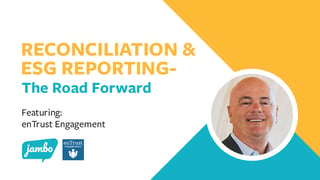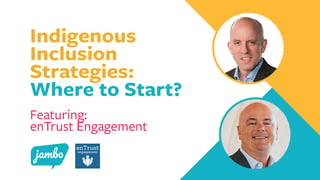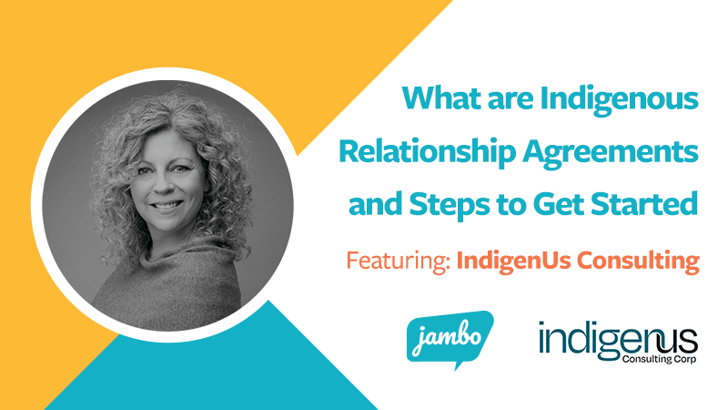
In this blog, we talk with the very knowledgeable, Dione McGuinness from IndigenUs Consulting, about Indigenous relationship agreements.
Dione’s career started about 20 years ago, working in communications with Indigenous communities along the Beaufort Sea, since that time she’s worked on many consultation and engagement projects that also include a lot of formalized training for project teams.
Dione has now set up her own company, IndigenUs Consulting Corporation, together with her husband, Doug Reti, a member of the Tr’ondëkHwëch’in First Nation in the Yukon territory. Previously, Doug was Director General of Aboriginal Policing for the RCMP. He is currently working with and on behalf of a First Nation-owned company to advance Indigenous reconciliation and economic development for their nation.
Below, Dione shares valuable steps and considerations to help you get started with Indigenous relationship agreements.
Q—What Is an Indigenous Relationship Agreement and What Are They Used For?
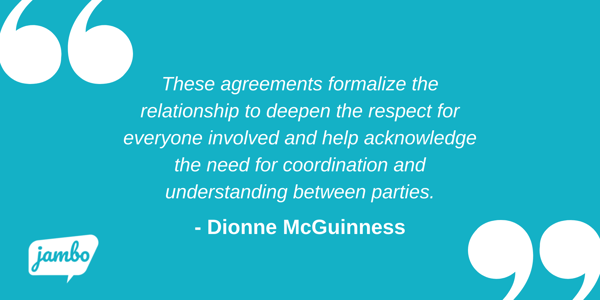
This is an agreement between an organization and a community that creates a deeper understanding of how they’ll work together and move forward through the challenges of developing and sharing the land together.
Treaty rights and Indigenous rights have often been ignored or misunderstood by proponents, so the purpose of a relationship agreement is to establish a long-term relationship based on cooperation, commitment, and communication that respects Indigenous communities' rights and jurisdiction.
These agreements formalize the relationship to deepen the respect for everyone involved and help acknowledge the need for coordination and understanding between parties.
Q—What Else Should People Know About Relationship Agreements?
These agreements can be a great way to work collaboratively with Indigenous communities outside the legal or regulatory framework. When you’re working with communities, you’ll always hear that it’s about the relationship and the trust that gets built—but it is really about the people. If an Indigenous community has experienced a break in trust or legacy trust issues exist, these agreements can reset that relationship and move things in a more positive direction.
These agreements are beneficial if:
- You’re coming into a new territory to develop land
- If you don’t know a community and you want to start things off in a positive way
- If you have experienced a breakdown in the relationship and you want to do a reset
What Are Some of The Elements That Go into These Agreements?
Each relationship agreement is unique, but some of the common elements include:
- Communication
- Engagement
- Economic development
- Employment
- Training
- Community investment
Things to consider when adding agreement elements:
- Who will you report to? Chief and Council? An advisory committee?
- How often will you send reports? On a monthly or quarterly basis?
- Will you be communicating within the broader community or strictly through the Chief and Council?
- For communities facing impacts from development projects, how can you work together to help fulfill some of their strategic needs?
- Are there funding shortfalls that should be addressed?
- Are there any opportunities that could be offered?
What Should Be Considered Before Creating a Relationship Agreement?
- Do you have the executive commitment and buy-in to do this? You want to set yourself up for success, so without the executive commitment, these agreements often go nowhere.
- Do you know why you’re entering into a relationship agreement? Do you have your priorities clarified? Are they well understood? Are you willing to listen to an Indigenous community and understand what’s important to them and incorporate some, or all, of their input into the agreement?
- Do you understand your internal capacity not only to develop the agreement, but enact it, follow up, and follow through on it?
- Do you understand the capacity of the community being engaged?
- If they have limited capacity, you might want to think about more simple agreements and reporting formats that don’t necessarily require as much ongoing communication.
- If you have an advisory committee set up for an agreement with members from each side, do they have the capacity for a formal meeting on a monthly or semi-monthly basis? It’s important to understand the capacity of the community being engaged.
- Do you understand the nature of your activities and the scope and impact of those activities in those traditional territories?
- Agreements may not always be the best option. If you’re a developer or explorer who doesn’t yet have a lot of interest in the area and just wants to drill a couple of wells, it may or may not be advantageous to enter into a relationship agreement.
- However, if you know you’re going to be there for the long-term, an agreement can be an effective way to ensure a longer standing and mutually cooperative relationship is in place.
Considerations For Remote Locations
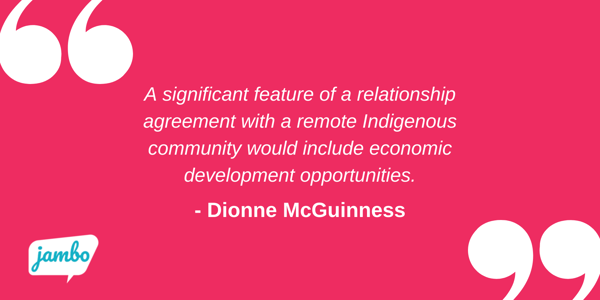
While there are exceptions, for the most part, you’ll see communities can be located quite remotely, and often coincide with areas that developers are looking at for resource extraction (mining, drilling, etc.). These remote locations don’t necessarily have the same opportunities for economic growth as urban locations, so typically a significant feature of a relationship agreement with a remote Indigenous community would include economic development opportunities.
Not All Communities Will Want an Agreement
Remember, not all communities want an agreement. It’s a conversation that can be explored very informally, and you can start those conversations with a question like: “what are the principles of engagement that you would like to see addressed?”
The answers will be unique for every community because there’s no homogeneity between communities. Everyone faces unique needs, has different capacities, and diverse priorities, so those things will need to be discussed early on and agreed upon between project proponents or organizations and the communities they are engaging with.
What Steps Would You Recommend for People to Get Started?
- Identify the Indigenous communities that will be covered by the agreement.
- Identify who can speak on behalf of each party.
- Identify the general spirit and intent of collaboration and communication as well as the consultation and engagement process.
- Remember, treaties were signed with a certain spirit and intent, so it’s important to understand that before entering the consultation and engagement process.
- When the duty to consult is triggered, if companies have done their work well and if they’ve signed these agreements, they already understand the concerns and capacities of the community, so entering into these agreements can facilitate a smoother consultation process overall.
- Identify how communication will occur between parties. For example:
- Formal communications: These can include joint statements, regular formal meetings, different community meetings, etc.
- Very formal communications: These are more for larger plans with larger impacts on the land and on treaty rights and Indigenous rights.
- Advisory committee communications: If there’s an advisory committee, how is it formed, and does it require terms of reference? If so, it should be included as an appendix to the relationship agreement.
- Informal communications: Identify what informal communication looks like and the preferences of each party. Some communities prefer email or text, while others prefer face-to-face or phone call communication.
- Identify areas of mutual interest that will help form those different elements of the agreement (e.g., economic development, internal capacity building, workforce development, training, hiring and mentorship, different community investment opportunities, etc.).
- Start tracking early: You'll want to track every conversation you have right from the development of the agreement and then throughout the lifetime of the relationship. Using a Stakeholder Relationship Management (SRM) software like Jambo can help you keep every interaction with communities organized and searchable so you can refer to help you build stronger relationships and trust between both parties.
A Collaborative and Mutually Agreed-Upon Process
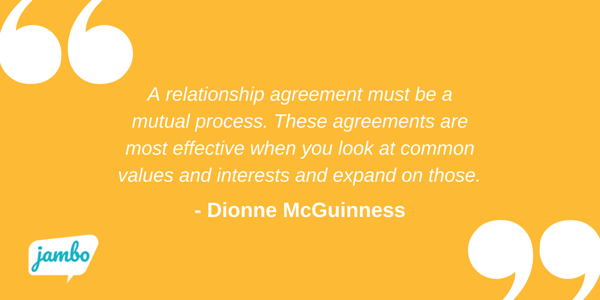
A relationship agreement must be a mutual process. These agreements are most effective when you look at common values and interests and expand on those. So, everybody is working together collaboratively and in the same direction for the benefit of both parties.
Remember to step back and have a conversation to help identify those areas of need and mutual understanding. Don't assume you know what a community needs or wants from these agreements; instead, listen to understand what's needed from their perspective. Even if you both arrive at the same conclusion, it will be much more powerful if you offer space for the community to share what they need (values, interests, concerns, and solutions) and work to support those. Supporting and allowing communities to achieve their own goals and objectives is important in the process of Reconciliation. We don’t make it happen; we support it happening—we let communities decide for themselves.
How Can IndigenUs Consulting Corporation Help with These Agreements?
Doug and I recognized that we both have a passion for creating capacity for growth and development on both sides. We have a desire to braid together Indigenous and Western perspectives to help facilitate Reconciliation opportunities that leave lasting impacts that benefit both organizations and the communities in whose territories they work.
So, we combined our unique skillsets and established our business to fill the need for facilitating these relationships more clearly, to help create more certainty and mutual benefit for everyone involved. One of the ways we can help facilitate these relationships and create a path forward is through relationship agreements.
Living with, working with, and being part of both Indigenous communities and the corporate world, we can help guide those who are interested or would like to go down this path. We can work with you and help you lay the foundation for successful engagement and inclusion.
To learn more about IndigenUs Consulting Corporation and how they can help, please visit their website.


